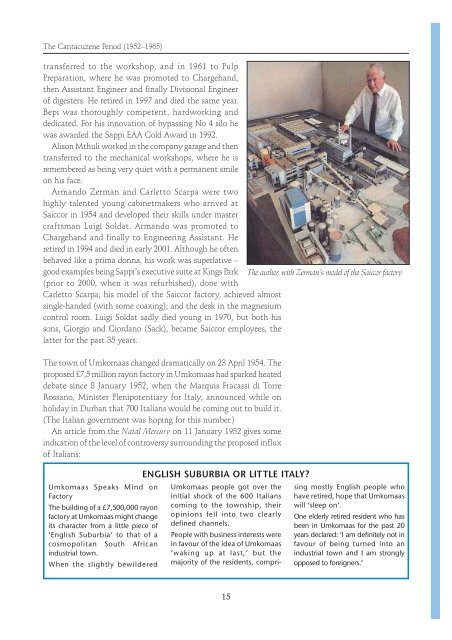Create successful ePaper yourself
Turn your PDF publications into a flip-book with our unique Google optimized e-Paper software.
<strong>The</strong> Cantacuzene Period (1952–1965)<br />
transferred to the workshop, and in 1961 to Pulp<br />
Preparation, where he was promoted to Chargehand,<br />
then Assistant Engineer and finally Divisional Engineer<br />
of digesters� He retired in 1997 and died the same year�<br />
Bepi was thoroughly competent, hardworking and<br />
dedicated� For his innovation of bypassing No 4 silo he<br />
was awarded the <strong>Sappi</strong> EAA Gold Award in 1992�<br />
Alison Mthuli worked in the company garage and then<br />
transferred to the mechanical workshops, where he is<br />
remembered as being very quiet with a permanent smile<br />
on his face�<br />
Armando Zerman and Carletto Scarpa were two<br />
highly talented young cabinetmakers who arrived at<br />
<strong>Saiccor</strong> in 1954 and developed their skills under master<br />
craftsman Luigi Soldat� Armando was promoted to<br />
Chargehand and finally to Engineering Assistant� He<br />
retired in 1994 and died in early 2001� Although he often<br />
behaved like a prima donna, his work was superlative –<br />
good examples being <strong>Sappi</strong>’s executive suite at Kings Park <strong>The</strong> author, with Zerman’s model of the <strong>Saiccor</strong> factory<br />
(prior to 2000, when it was refurbished), done with<br />
Carletto Scarpa; his model of the <strong>Saiccor</strong> factory, achieved almost<br />
single-handed (with some coaxing); and the desk in the magnesium<br />
control room� Luigi Soldat sadly died young in 1970, but both his<br />
sons, Giorgio and Giordano (Sack), became <strong>Saiccor</strong> employees, the<br />
latter for the past 35 years�<br />
<strong>The</strong> town of Umkomaas changed dramatically on 23 April 1954� <strong>The</strong><br />
proposed £7,5 million rayon factory in Umkomaas had sparked heated<br />
debate since 8 January 1952, when the Marquis Fracassi di Torre<br />
Rossano, Minister Plenipotentiary for Italy, announced while on<br />
holiday in Durban that 700 Italians would be coming out to build it�<br />
(<strong>The</strong> Italian government was hoping for this number�)<br />
An article from the Natal Mercury on 11 January 1952 gives some<br />
indication of the level of controversy surrounding the proposed influx<br />
of Italians:<br />
Umkomaas Speaks Mind on<br />
Factory<br />
<strong>The</strong> building of a £7,<strong>50</strong>0,000 rayon<br />
factory at Umkomaas might change<br />
its character from a little piece of<br />
‘English Suburbia’ to that of a<br />
cosmopolitan South African<br />
industrial town�<br />
When the slightly bewildered<br />
ENGLISH SUBURBIA OR LITTLE ITALY?<br />
Umkomaas people got over the<br />
initial shock of the 600 Italians<br />
coming to the township, their<br />
opinions fell into two clearly<br />
defined channels�<br />
People with business interests were<br />
in favour of the idea of Umkomaas<br />
‘waking up at last,’ but the<br />
majority of the residents, compri-<br />
15<br />
sing mostly English people who<br />
have retired, hope that Umkomaas<br />
will ‘sleep on’�<br />
One elderly retired resident who has<br />
been in Umkomaas for the past 20<br />
years declared: ‘I am definitely not in<br />
favour of being turned into an<br />
industrial town and I am strongly<br />
opposed to foreigners�’

















